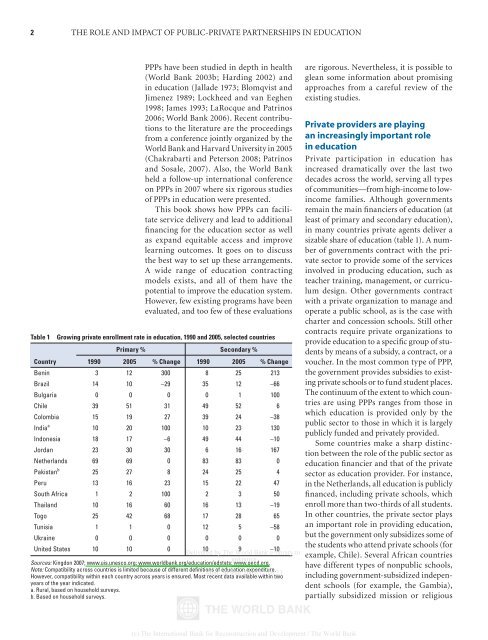The Role and Impact of Public-Private Partnerships in Education
The Role and Impact of Public-Private Partnerships in Education
The Role and Impact of Public-Private Partnerships in Education
You also want an ePaper? Increase the reach of your titles
YUMPU automatically turns print PDFs into web optimized ePapers that Google loves.
2 THE ROLE AND IMPACT OF PUBLIC-PRIVATE PARTNERSHIPS IN EDUCATION<br />
Table 1<br />
PPPs have been studied <strong>in</strong> depth <strong>in</strong> health<br />
(World Bank 2003b; Hard<strong>in</strong>g 2002) <strong>and</strong><br />
<strong>in</strong> education (Jallade 1973; Blomqvist <strong>and</strong><br />
Jimenez 1989; Lockheed <strong>and</strong> van Eeghen<br />
1998; James 1993; LaRocque <strong>and</strong> Patr<strong>in</strong>os<br />
2006; World Bank 2006). Recent contributions<br />
to the literature are the proceed<strong>in</strong>gs<br />
from a conference jo<strong>in</strong>tly organized by the<br />
World Bank <strong>and</strong> Harvard University <strong>in</strong> 2005<br />
(Chakrabarti <strong>and</strong> Peterson 2008; Patr<strong>in</strong>os<br />
<strong>and</strong> Sosale, 2007). Also, the World Bank<br />
held a follow-up <strong>in</strong>ternational conference<br />
on PPPs <strong>in</strong> 2007 where six rigorous studies<br />
<strong>of</strong> PPPs <strong>in</strong> education were presented.<br />
This book shows how PPPs can facilitate<br />
service delivery <strong>and</strong> lead to additional<br />
f<strong>in</strong>anc<strong>in</strong>g for the education sector as well<br />
as exp<strong>and</strong> equitable access <strong>and</strong> improve<br />
learn<strong>in</strong>g outcomes. It goes on to discuss<br />
the best way to set up these arrangements.<br />
A wide range <strong>of</strong> education contract<strong>in</strong>g<br />
models exists, <strong>and</strong> all <strong>of</strong> them have the<br />
potential to improve the education system.<br />
However, few exist<strong>in</strong>g programs have been<br />
evaluated, <strong>and</strong> too few <strong>of</strong> these evaluations<br />
Grow<strong>in</strong>g private enrollment rate <strong>in</strong> education, 1990 <strong>and</strong> 2005, selected countries<br />
Primary % Secondary %<br />
Country 1990 2005 % Change 1990 2005 % Change<br />
Ben<strong>in</strong> 3 12 300 8 25 213<br />
Brazil 14 10 –29 35 12 –66<br />
Bulgaria 0 0 0 0 1 100<br />
Chile 39 51 31 49 52 6<br />
Colombia 15 19 27 39 24 –38<br />
India a 10 20 100 10 23 130<br />
Indonesia 18 17 –6 49 44 –10<br />
Jordan 23 30 30 6 16 167<br />
Netherl<strong>and</strong>s 69 69 0 83 83 0<br />
Pakistan b 25 27 8 24 25 4<br />
Peru 13 16 23 15 22 47<br />
South Africa 1 2 100 2 3 50<br />
Thail<strong>and</strong> 10 16 60 16 13 –19<br />
Togo 25 42 68 17 28 65<br />
Tunisia 1 1 0 12 5 –58<br />
Ukra<strong>in</strong>e 0 0 0 0 0 0<br />
United States 10 10 0<br />
Delivered<br />
10<br />
by <strong>The</strong> World<br />
9<br />
Bank e-library<br />
–10<br />
to:<br />
unknown<br />
Sources: K<strong>in</strong>gdon 2007; www.uis.unesco.org; www.worldbank.org/education/edstats; www.oecd.org.<br />
IP : 192.86.100.35<br />
Note: Compatibility across countries is limited because <strong>of</strong> different def<strong>in</strong>itions <strong>of</strong> education expenditure.<br />
Mon, 30 Mar 2009 12:16:23<br />
However, compatibility with<strong>in</strong> each country across years is ensured. Most recent data available with<strong>in</strong> two<br />
years <strong>of</strong> the year <strong>in</strong>dicated.<br />
a. Rural, based on household surveys.<br />
b. Based on household surveys.<br />
are rigorous. Nevertheless, it is possible to<br />
glean some <strong>in</strong>formation about promis<strong>in</strong>g<br />
approaches from a careful review <strong>of</strong> the<br />
exist<strong>in</strong>g studies.<br />
<strong>Private</strong> providers are play<strong>in</strong>g<br />
an <strong>in</strong>creas<strong>in</strong>gly important role<br />
<strong>in</strong> education<br />
<strong>Private</strong> participation <strong>in</strong> education has<br />
<strong>in</strong>creased dramatically over the last two<br />
decades across the world, serv<strong>in</strong>g all types<br />
<strong>of</strong> communities—from high-<strong>in</strong>come to low<strong>in</strong>come<br />
families. Although governments<br />
rema<strong>in</strong> the ma<strong>in</strong> f<strong>in</strong>anciers <strong>of</strong> education (at<br />
least <strong>of</strong> primary <strong>and</strong> secondary education),<br />
<strong>in</strong> many countries private agents deliver a<br />
sizable share <strong>of</strong> education (table 1). A number<br />
<strong>of</strong> governments contract with the private<br />
sector to provide some <strong>of</strong> the services<br />
<strong>in</strong>volved <strong>in</strong> produc<strong>in</strong>g education, such as<br />
teacher tra<strong>in</strong><strong>in</strong>g, management, or curriculum<br />
design. Other governments contract<br />
with a private organization to manage <strong>and</strong><br />
operate a public school, as is the case with<br />
charter <strong>and</strong> concession schools. Still other<br />
contracts require private organizations to<br />
provide education to a specific group <strong>of</strong> students<br />
by means <strong>of</strong> a subsidy, a contract, or a<br />
voucher. In the most common type <strong>of</strong> PPP,<br />
the government provides subsidies to exist<strong>in</strong>g<br />
private schools or to fund student places.<br />
<strong>The</strong> cont<strong>in</strong>uum <strong>of</strong> the extent to which countries<br />
are us<strong>in</strong>g PPPs ranges from those <strong>in</strong><br />
which education is provided only by the<br />
public sector to those <strong>in</strong> which it is largely<br />
publicly funded <strong>and</strong> privately provided.<br />
Some countries make a sharp dist<strong>in</strong>ction<br />
between the role <strong>of</strong> the public sector as<br />
education f<strong>in</strong>ancier <strong>and</strong> that <strong>of</strong> the private<br />
sector as education provider. For <strong>in</strong>stance,<br />
<strong>in</strong> the Netherl<strong>and</strong>s, all education is publicly<br />
f<strong>in</strong>anced, <strong>in</strong>clud<strong>in</strong>g private schools, which<br />
enroll more than two-thirds <strong>of</strong> all students.<br />
In other countries, the private sector plays<br />
an important role <strong>in</strong> provid<strong>in</strong>g education,<br />
but the government only subsidizes some <strong>of</strong><br />
the students who attend private schools (for<br />
example, Chile). Several African countries<br />
have different types <strong>of</strong> nonpublic schools,<br />
<strong>in</strong>clud<strong>in</strong>g government-subsidized <strong>in</strong>dependent<br />
schools (for example, the Gambia),<br />
partially subsidized mission or religious<br />
(c) <strong>The</strong> International Bank for Reconstruction <strong>and</strong> Development / <strong>The</strong> World Bank
















